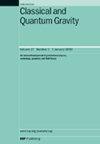积分能量条件下的Penrose不等式
IF 3.7
3区 物理与天体物理
Q2 ASTRONOMY & ASTROPHYSICS
引用次数: 0
摘要
经典的彭罗斯不等式(ADM质量与黑洞事件视界任意横截面面积之间的关系)被引入,作为对弱宇宙审查猜想的测试:如果它失败,被捕获的表面不一定在事件视界后面,并且可能形成裸奇点。自最初的推导以来,各种各样的证明已经发展起来,主要集中在时空的最大类空间切片的初始数据公式上。这些证明大多只适用于经典场,因为在量子场论的背景下,所需的能量条件是违反的。本文对球对称时空的Penrose不等式进行了两种推广:利用初始数据和平均能量条件证明经典Penrose不等式,并结合弱宇宙审查猜想证明了蒸发黑洞的修正Penrose不等式。后一种情况也可以适用于量子场,因为它使用了由量子能量不平等启发的条件。最后,我们为两者提供了物理动机的例子。本文章由计算机程序翻译,如有差异,请以英文原文为准。
Penrose inequality for integral energy conditions
The classical Penrose inequality, a relation between the ADM mass and the area of any cross section of the black hole event horizon, was introduced as a test of the weak cosmic censorship conjecture: if it fails, the trapped surface is not necessarily behind the event horizon and a naked singularity could form. Since that original derivation, a variety of proofs have developed, mainly focused on the initial data formulation on maximal spacelike slices of spacetime. Most of these proofs are applicable only for classical fields, as the energy conditions required are violated in the context of quantum field theory. In this work we provide two generalizations of the Penrose inequality for spherically symmetric spacetimes: a proof of a classical Penrose inequality using initial data and an average energy condition, and a proof of a modified Penrose inequality for evaporating black holes with a connection to the weak cosmic censorship conjecture. The latter case could also be applicable to quantum fields as it uses a condition inspired by quantum energy inequalities. Finally, we provide physically motivated examples for both.
求助全文
通过发布文献求助,成功后即可免费获取论文全文。
去求助
来源期刊

Classical and Quantum Gravity
物理-天文与天体物理
CiteScore
7.00
自引率
8.60%
发文量
301
审稿时长
2-4 weeks
期刊介绍:
Classical and Quantum Gravity is an established journal for physicists, mathematicians and cosmologists in the fields of gravitation and the theory of spacetime. The journal is now the acknowledged world leader in classical relativity and all areas of quantum gravity.
 求助内容:
求助内容: 应助结果提醒方式:
应助结果提醒方式:


